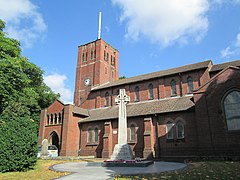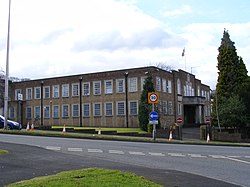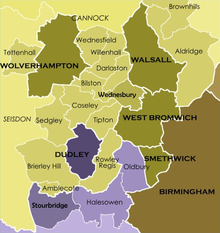Rowley Regis
| Rowley Regis | |
|---|---|
 St Giles' Church, parish church of Rowley Regis | |
 Rowley Regis Location within the West Midlands | |
| Population | 50,257 (2011)[a] |
| OS grid reference | SO9687 |
| Metropolitan borough | |
| Metropolitan county | |
| Region | |
| Country | England |
| Sovereign state | United Kingdom |
| Post town | CRADLEY HEATH |
| Postcode district | B64 |
| Post town | ROWLEY REGIS |
| Postcode district | B65 |
| Dialling code | 0121 01384 |
| Police | West Midlands |
| Fire | West Midlands |
| Ambulance | West Midlands |
| UK Parliament | |
Rowley Regis (/ˌraʊli ˈriːdʒɪs/ ROW-lee REE-jis) is a historic parish and former municipal borough in the Black Country region of the West Midlands, England. Considered one of the six 'towns' that comprise the modern-day Sandwell Metropolitan Borough,[2] it encompasses the Sandwell council wards of Blackheath, Cradley Heath & Old Hill, and Rowley.[3] At the 2011 census, the combined population of these wards was 50,257.[1]
History[]
The history of Rowley Regis began in the 12th century,[4] when a small village grew around the parish church of St. Giles, 2 miles (3 kilometres) southeast of Dudley. Rowley was part of the Royal hunting grounds - Regis was added to the name of Rowley in around 1140 to signify it was that part of Rowley belonging to the King. It began to develop substantially between the two World Wars, when thousands of privately owned and local authority houses were built in the surrounding area. During that time Rowley Regis became a borough, and incorporated the communities of Blackheath, Old Hill, and Cradley Heath. These places were all within the ancient parish of Rowley Regis, which (despite being in the county of Staffordshire) was in the diocese of Worcester. The parish contained the manors of Rowley Regis and Rowley Somery, the latter being part of the barony of Dudley, but the extents of these manors and the relationship between them are not clear.
The present St. Giles Church on Church Road is not the original church in Rowley Regis. The church built in 1840 to succeed the original mediaeval building, was found to be unsafe and condemned in 1900. The next church, built in 1904, was burned down in 1913, some believing the fire to have been started by Suffragettes or local striking steelworkers; this however is supposition and it was more than probable it was a simple accident, the church at this time using paraffin as a means of lighting and the latter perhaps causing the fire. Its present day successor was designed by Holland W. Hobbiss and A. S. Dixon, and was built in 1923.[5]

Rowley Regis railway station opened in 1867 in the south of the then village, and remains in use to this day.
Rowley's grammar school was opened on Hawes Lane in September 1962. Well-known former pupils include Pete Williams (original bass player with Dexys Midnight Runners), and actress Josie Lawrence. In 1974, when comprehensive schools became universal in the new borough of Sandwell, the grammar school became Rowley Regis Sixth Form College, the last intake of grammar school pupils having been inducted the previous year. In 2003 it became an annexe of Dudley College, but this arrangement lasted just one year before the buildings fell into disuse. It was demolished three years later, and the site was redeveloped as the new Rowley Learning Campus under Sandwell's Building Schools for the Future programme,[6] comprising St Michael's Church of England High School, Westminster Special School, and Whiteheath Education Centre, which opened in September 2011.
| Rowley Regis Borough of Rowley Regis | |
|---|---|
| Municipal borough | |
 Former Rowley Regis Council House, demolished in 2012 | |
| Population | |
| • 1911 | 37,000[7] |
| • 1961 | 48,146 |
| History | |
| • Preceded by | Sanitary district |
| • Created | 1894 |
| • Abolished | 1966 |
| • Succeeded by | County Borough of Warley Sandwell Metropolitan Borough |
| Status | Urban district (1894-1933) Municipal borough (1933-1966) |
| Government | Rowley Regis Borough Council |
| • HQ | Council House, Old Hill |
| • Motto | "Loyal and Industrious" |
 Arms of Rowley Regis Borough Council | |
Civic history[]
Originally in Staffordshire, the Rowley Regis Urban District was formed in 1894 to cover the villages of Rowley, Blackheath, Cradley Heath, and Old Hill. The urban district was incorporated into a municipal borough in 1933.[8] Following the acquisition of borough status, plans were unveiled to build new council offices in the borough to replace the existing offices in Lawrence Lane, Old Hill. A site on the corner of Halesowen Road and Barrs Road was selected, with working commencing in October 1937, and the building being completed in December 1938.

In 1966, the borough of Rowley Regis merged with the boroughs of Oldbury and Smethwick to form the Warley County Borough,[9] and became part of Worcestershire. There had previously been plans to incorporate Rowley Regis into an expanded Dudley borough, and for Halesowen to join up with Oldbury and Smethwick instead.[citation needed]
Eight years later, in 1974, on the formation of the West Midlands Metropolitan county, Warley merged with West Bromwich to form the Sandwell Metropolitan Borough. It is now right in the core of the West Midlands conurbation.
Following the demise of Rowley Regis as a standalone borough in 1966, the council offices in Barrs Road were retained by Warley council and then by Sandwell council. However, a plan was submitted in July 2012 by Sandwell Leisure Trust to demolish the buildings to make way for an expansion to the neighbouring Haden Hill Leisure Centre, and the development of a new fire station.[10]
The archives for Rowley Regis Borough are held at Sandwell Community History and Archives Service.
Geography[]

Rowley Regis is the location of the Rowley Hills, famed for the quarrying of Rowley Rag Stone. The hills form part of the east/west watershed between the rivers Trent and Severn,[11] and contain the highest point in the West Midlands region, Turner's Hill, at 269m above sea level.[12]
Localities (former borough of Rowley Regis)[]
- Blackheath
- Cradley Heath
- Haden Hill
- Old Hill
- Rowley Village
- Whiteheath
Famous residents[]
This section needs additional citations for verification. (July 2017) |
- Josie Lawrence – British actress, was educated at Rowley Regis Grammar School (1970–75).
- Cobie Harrison - Cofounder of Coboss Industries and author of ‘An industrial history of Birmingham and the Black Country’.
- Pete Williams – bass player with Dexys Midnight Runners between 1978 and 1981, was educated at Rowley Regis Grammar School (1971–1976).
- John Haden Badley – centenarian and founder of Bedales School grew up spending time at his family's country home "Foxcote" and visiting his uncle and cousins at Haden Hill.
- Carlton Palmer – former footballer who played for the England team as well as clubs including West Bromwich Albion, Sheffield Wednesday and Leeds United.
- George Smith 1805–1874 – executioner (period in office 1849–1872). George Smith was born in Rowley Regis in 1805 and was a prisoner himself at Stafford when he entered the "trade" as an assistant to William Calcraft. His first job was assisting at the double hanging of James Owen and George Thomas outside Stafford Gaol on 11 April 1840. He learnt the job and was able to perform executions himself, principally in the Midlands. Smith's most famous solo execution was that of the Rugeley poisoner, Dr William Palmer for the murder of John Parsons Cook, before a large crowd at Stafford Gaol on 14 June 1856. Smith was to hang a further 14 men and one woman at Stafford, the last in August 1872. He assisted Calcraft at the first private hanging in England (of Thomas Wells see below) in August 1868. He was renowned for his long white coat and top hat which he wore at public hangings. Smith's son, also George, assisted at three executions at Stafford prison. Initially, it is said that he was hired by the Under Sheriff of Staffordshire to save the cost of bringing Calcraft up from London. With the advent of a good rail network, Smith, like Askern and Calcraft, could operate much further afield in later years. George Smith carried out two private executions, the last at Stafford on 13 August 1872, when he hanged 34-year-old Christopher Edwards for the murder of his wife.
- James Woodhouse 1735-1820 - poet, born in Rowley Regis, known as the "cobbler poet".[13]
- The poet, W. H. Auden’s ancestors were from Rowley Regis. His great-great-great grandfather, William Auden (1726-1794), owned or leased mines in the area. The poet’s grandfather, Rev. John Auden (1831-1876), was born in Rowley Regis.
See also[]
Notes[]
References[]
- ^ Jump up to: a b "Census 2011 Key Stats". Sandwell Trends. Sandwell Metropolitan Borough Council. Retrieved 2 July 2013.
- ^ "Where is Sandwell?". Tourism and Travel. Sandwell Council. Retrieved 9 October 2012.
- ^ "About". I love Rowley Regis. rowleyregis.com. Retrieved 9 October 2012.
- ^ "Rowley Timeline". Rowley Village and Rowley Regis. Retrieved 9 October 2012.
- ^ The Buildings of England: Worcestershire, Nikolaus Pevsner, 1963 p89
- ^ Sandwell Metropolitan Borough Council: Building Schools for the Future www.bsf.sandwell.gov.uk
- ^ "Rowley Regis UD/MD through time - Population Statistics - Total Population". A Vision of Britain through Time. GB Historical GIS/University of Portsmouth. Retrieved 15 April 2017.
- ^ [1]
- ^ "Rowley Regis UD/MB Through Time - Census tables with data for the Local Government District". A Vision of Britain through Time. GB Historical GIS/University of Portsmouth. Retrieved 15 April 2017.
- ^ [2]
- ^ "The Rowley Hills". Birmingham and Black Country Wildlife Trust. Retrieved 6 April 2013.
- ^ "West Midlands". Destinations. Live for the Outdoors. Archived from the original on 1 November 2012. Retrieved 6 April 2013.
- ^ Hackwood, Frederick William (1911). Staffordshire Worthies. Stafford: Chronicle Press. pp. 83-87. Retrieved 4 February 2019.
External links[]
| Wikisource has the text of the 1905 New International Encyclopedia article "Rowley Regis". |
- Rowley Regis
- Towns in the West Midlands (county)
